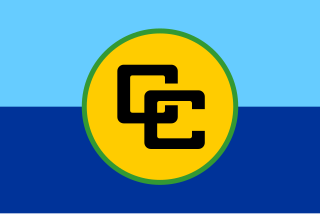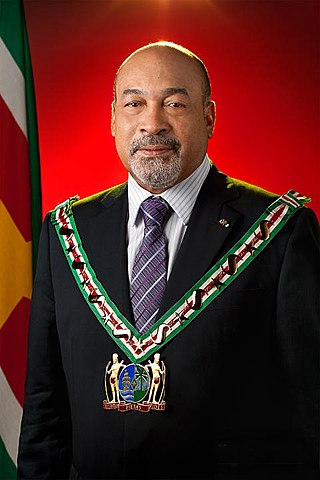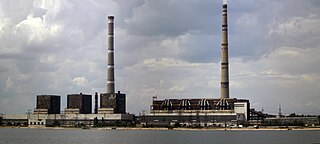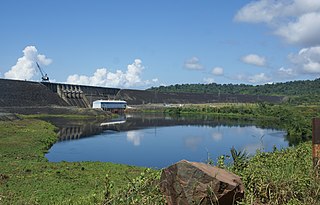Contents
This February 2024 needs additional citations for verification .(February 2024) |
This article lists all power stations in Suriname .
This February 2024 needs additional citations for verification .(February 2024) |
This article lists all power stations in Suriname .
| Hydroelectric station | River | Type | Reservoir | Capacity | Year completed |
|---|---|---|---|---|---|
| Afobaka [1] | Suriname River | Reservoir | Brokopondo Reservoir | 189 MW | 1964 |
| Puketi hydroelectric power plant | Tapanahony River | run-of-the-river | 50 kW | 1981 | |
| Gran Olo hydroelectric power plant | Tapanahony River | run-of-the-river | 300 kW | (2016) |
| Thermal power station | Community | Coordinates | Fuel type | Capacity | Year completed | Owner |
|---|---|---|---|---|---|---|
| EBS Saramaccastraat | Paramaribo | Diesel fuel | 135 MW (72 MW + 63 MW) | 63 MW extension completed in 2013 | EBS | |
| Staatsolie | Heavy fuel oil | 28 MW | Staatsolie | |||
| Paranam | Fuel oil | 47 MW | 1963 and 1965 | Paranam |

Suriname, officially the Republic of Suriname, is a country in northern South America. Situated slightly north of the equator within the tropics, over 90% of its territory is covered by rainforests, the highest proportion of forest cover in the world. Suriname is bordered by the Atlantic Ocean to the north, French Guiana to the east, Guyana to the west, and Brazil to the south. It is the smallest country in South America by both population and territory, with around 612,985 inhabitants in an area of approximately 163,820 square kilometers. The capital and largest city is Paramaribo, home to roughly half the population.

Politics of Suriname take place in a framework of a parliamentary representative democratic assembly-independent republic, whereby the president of Suriname is the head of state and head of government, and of a pluriform multi-party system. Executive power is exercised by the government. The executive power is dependent on the Parliament in theory. Legislative power is vested in both the government and the National Assembly. The judiciary is independent of the executive and the legislature.

The Republic of Suriname has a number of forms of transport. Transportation emissions are an increasing part of Suriname's contributions to climate change, as part of the Nationally Determined Contributions for the Paris Agreement, Suriname has committed to emissions controls for vehicles and increased public transit investment.

The Caribbean Community is an intergovernmental organisation that is a political and economic union of 15 member states throughout the Americas and Atlantic Ocean. They have primary objectives to promote economic integration and cooperation among its members, ensure that the benefits of integration are equitably shared, and coordinate foreign policy. The organisation was established in 1973, with its four founding members signing the Treaty of Chaguaramas. Its primary activities involve:

Desiré Delano Bouterse is a Surinamese military officer, politician, convicted murderer and drug trafficker who served as President of Suriname from 2010 to 2020. From 1980 to 1987, he was Suriname's de facto leader after conducting a military coup and establishing a period of military rule. In 1987, Bouterse founded the National Democratic Party (NDP). On 25 May 2010, Bouterse's political alliance, the Megacombinatie, which included the NDP, won the parliamentary elections, and on 19 July 2010, Bouterse was elected as President of Suriname with 36 of 50 parliament votes. He was inaugurated on 12 August 2010.

Hydroelectricity, or hydroelectric power, is electricity generated from hydropower. Hydropower supplies one sixth of the world's electricity, almost 4,500 TWh in 2020, which is more than all other renewable sources combined and also more than nuclear power. Hydropower can provide large amounts of low-carbon electricity on demand, making it a key element for creating secure and clean electricity supply systems. A hydroelectric power station that has a dam and reservoir is a flexible source, since the amount of electricity produced can be increased or decreased in seconds or minutes in response to varying electricity demand. Once a hydroelectric complex is constructed, it produces no direct waste, and almost always emits considerably less greenhouse gas than fossil fuel-powered energy plants. However, when constructed in lowland rainforest areas, where part of the forest is inundated, substantial amounts of greenhouse gases may be emitted.

The president of the Republic of Suriname is, in accordance with the Constitution of 1987, the head of state and head of government of Suriname, and commander-in-chief of the Suriname National Army (SNL). The president also appoints a cabinet.

Sipaliwini is the largest district of Suriname, located in the south. Sipaliwini is the only district that does not have a regional capital, as it is directly administered by the national government in Paramaribo. Sipaliwini District includes disputed areas, with the southwestern region controlled and administered by Guyana, whereas the southeastern region is controlled by French Guiana.
Anthony Conrad Nesty is a former competition swimmer from Suriname who was an Olympic gold medallist in the 100-metre butterfly event in 1988. He is currently the head coach of the Florida Gators men's and women's swim team at the University of Florida, where he attended school.

The Suriname national football team represents Suriname in international football. The team is controlled by the Surinamese Football Association, which is a member of CONCACAF.

The Guyana national football team, nicknamed the Golden Jaguars, represents Guyana in international football and is controlled by the Guyana Football Federation. It is one of three South American nations to be a member of the Caribbean Football Union of CONCACAF alongside Suriname and French Guiana. Until the independence of Guyana in 1966, it competed as British Guiana. They qualified for the Caribbean Nations Cup in 1991, coming fourth, and in 2007. Guyana has never qualified for the FIFA World Cup, but on 23 March 2019 they qualified for the first time for the CONCACAF Gold Cup.

Vuhlehirska power station is a fossil fueled thermal power station located in Svitlodarsk, Ukraine. It consists of 7 units with a total power output of 3,600 MW and was put in service between 1972 and 1977. The power station has 4 coal fired units which operate regularly as a base-load power source, and 3 gas fired boilers which are used as peaking units. The Vuhlehirska power station has a flue gas stack that is 320 meters tall, which is one of the tallest structures in Ukraine. Since August 1995 the power station is operated by Centrenergo. The power station has an outward appearance similar to that of the Zaporizhzhia thermal power station as they were both constructed in the early 1970s
Rudi Kappel Airstrip is located 9 kilometres (5.6 mi) south of the Tafelberg tepui in Suriname. It was constructed as part of Operation Grasshopper. It used to be named Tafelberg Airstrip, but was renamed Rudi Kappel Airstrip, after the co-pilot of a flight that crashed near Vincent Fayks Airport on 6 October 1959.
Kriel Power Station in Mpumalanga, South Africa, is a coal-fired power plant operated by Eskom. It is located about 4 km from Matla Power Station just outside the town of Kriel.
Miss Suriname is a national Beauty pageant in Suriname. The pageant is now under Tropical Beauties Suriname Foundation which selected the titleholders to Miss World, Miss Universe, Miss International, Miss Earth, Miss Supranational and Mister Supranational.

The Afobaka Dam is an embankment dam with a main gravity dam section on the Suriname River near Afobaka in Brokopondo District of Suriname. The primary purpose of the dam is to generate hydroelectric power and it supports a 180 MW power station. In 1958, Suriname Aluminum Company LLC (Suralco), a subsidiary of Alcoa, gained an agreement with the Suriname government to build the dam to power an aluminium smelter. Construction began in 1961 and it was completed in 1964. About 75% of power generated is used for processing aluminum, the rest is used in Paramaribo downstream. The power station was operational in 1965 but the very large reservoir, Brokopondo Reservoir, was not completely filled until 1971. Greenhouse gases emitted from the reservoir resulted in poor water quality for decades. Highly acidic water also damaged the power station's turbines.

The history of Suriname during World War II was mainly focused on protecting the bauxite industry and guarding the borders with French Guiana which was part of Vichy France. From November 1941 onwards, 2,000 American troops were stationed in Suriname who transformed Airstrip Zanderij into a major airport, and constructed defensive works. No actual battles took place in Suriname. There was a political crisis in 1943, because Governor Johannes Kielstra used the state of emergency to imprison political opponents.